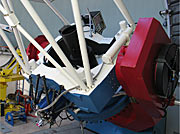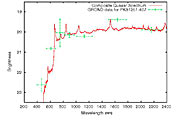Press Release
GROND Takes Off
First Light for Gamma-Ray Burst Chaser at La Silla
6 July 2007
A new instrument has seen First Light at the ESO La Silla Observatory. Equipping the 2.2-m MPI/ESO telescope, GROND takes images simultaneously in seven colours. It will be mostly used to determine distances of gamma-ray bursts.
Taking images in different filters simultaneously is important for the study of many astrophysical sources, and in particular of variable sources, such as close binaries or active galactic nuclei. But it is most crucial in the follow-up of gamma-ray bursts. Gamma-ray bursts (GRBs) are short flashes of energetic gamma-rays lasting from less than a second to several minutes. They release a tremendous quantity of energy in this short time making them the most powerful events since the Big Bang.
Gamma-ray bursts, which are invisible to our eyes, are discovered by telescopes in space. After releasing their intense burst of high-energy radiation, they become detectable for a fleeting moment in the optical and in the near-infrared. This 'afterglow' fades very rapidly, making detailed analysis possible for only a few hours after the gamma-ray detection. This analysis is important in particular in order to determine the GRB's distance and, hence, intrinsic brightness.
A first determination of the distance can be done by taking images through different filters, using the so-called photometric redshift [1]. Because a typical GRB afterglow becomes 15 times fainter after just 10 minutes, and over 200 times fainter after an hour, it is important to observe the object in as many filters as possible simultaneously.
"To make the determination of distance of far-away objects as accurate as possible, we decided to use four different filters in the optical and three different filters in the near-infrared," says Jochen Greiner, who led the development of the GROND instrument. GROND stands for Gamma-Ray burst Optical/Near-Infrared Detector.
GROND takes thus images of the same region of the sky in 7 different filters. The field of view in the near-infrared is 10 times 10 arcminutes, or 1/7th the area of the Full Moon. It is smaller in the visible, slightly above 5 x 5 arcmin.
GROND is presently in its commissioning phase and its first science demonstration has been achieved, showing that all technical systems work properly. In particular, GROND observed a quasar located more than 12 billion light-years away.
As for many instruments specialising in the follow-up of gamma-ray bursts, GROND can also be activated with a Rapid Response Mode (RRM): GRB alerts will be automatically fed into the system thus minimising the delay between the gamma-ray burst detection by a satellite and its observation by GROND.
"The implementation of the RRM at the 2.2-m telescope is done in exactly the same way as for the VLT, and boosts ESO's leadership to offer observing systems with ultra fast response time towards GRB follow-up," says Michael Sterzik, Head of Science Operations Department at ESO La Silla.
A dedicated data analysis pipeline is also being tested which will provide the distance of the burst a few minutes after the first observations.
"Ultimately, the goal is to trigger ESO's VLT to perform spectroscopy of the source with fine-tuned settings, thereby maximising the scientific return of GRB follow-up observations of the VLT," says Greiner.
GROND has been built by the Max-Planck Institute for Extraterrestrial Physics in collaboration with the Thüringer Landessternwarte Tautenburg.
Notes
[1] The photometric redshift method makes it possible to judge the distance to a remote celestial object (a galaxy, a quasar, a gamma-ray burst afterglow) from its measured colours. It is based on the proportionality between the distance and the velocity along the line of sight (Hubble's law) that reflects the expansion of the Universe. The larger the distance of an object is, the larger is its velocity and, due to the Doppler effect, the spectral shift of its emission towards longer (redder) wavelengths. Thus, the measured colour provides a rough indication of the distance.
Contacts
Jochen Greiner
MPI f. extraterrestrical Physics
Garching, Germany
Tel: +49-89-30000-3847
Email: jcg@mpe.mpg.de
Michael Sterzik
ESO
Chile
Email: msterzik@eso.org
About the Release
| Release No.: | eso0730 |
| Legacy ID: | PR 30/07 |
| Name: | MPG/ESO 2.2-metre telescope, PKS 1251-407 |
| Type: | Unspecified : Technology : Observatory : Instrument |
| Facility: | MPG/ESO 2.2-metre telescope |
| Instruments: | GROND |
Our use of Cookies
We use cookies that are essential for accessing our websites and using our services. We also use cookies to analyse, measure and improve our websites’ performance, to enable content sharing via social media and to display media content hosted on third-party platforms.
ESO Cookies Policy
The European Organisation for Astronomical Research in the Southern Hemisphere (ESO) is the pre-eminent intergovernmental science and technology organisation in astronomy. It carries out an ambitious programme focused on the design, construction and operation of powerful ground-based observing facilities for astronomy.
This Cookies Policy is intended to provide clarity by outlining the cookies used on the ESO public websites, their functions, the options you have for controlling them, and the ways you can contact us for additional details.
What are cookies?
Cookies are small pieces of data stored on your device by websites you visit. They serve various purposes, such as remembering login credentials and preferences and enhance your browsing experience.
Categories of cookies we use
Essential cookies (always active): These cookies are strictly necessary for the proper functioning of our website. Without these cookies, the website cannot operate correctly, and certain services, such as logging in or accessing secure areas, may not be available; because they are essential for the website’s operation, they cannot be disabled.
Functional Cookies: These cookies enhance your browsing experience by enabling additional features and personalization, such as remembering your preferences and settings. While not strictly necessary for the website to function, they improve usability and convenience; these cookies are only placed if you provide your consent.
Analytics cookies: These cookies collect information about how visitors interact with our website, such as which pages are visited most often and how users navigate the site. This data helps us improve website performance, optimize content, and enhance the user experience; these cookies are only placed if you provide your consent. We use the following analytics cookies.
Matomo Cookies:
This website uses Matomo (formerly Piwik), an open source software which enables the statistical analysis of website visits. Matomo uses cookies (text files) which are saved on your computer and which allow us to analyze how you use our website. The website user information generated by the cookies will only be saved on the servers of our IT Department. We use this information to analyze www.eso.org visits and to prepare reports on website activities. These data will not be disclosed to third parties.
On behalf of ESO, Matomo will use this information for the purpose of evaluating your use of the website, compiling reports on website activity and providing other services relating to website activity and internet usage.
Matomo cookies settings:
Additional Third-party cookies on ESO websites: some of our pages display content from external providers, e.g. YouTube.
Such third-party services are outside of ESO control and may, at any time, change their terms of service, use of cookies, etc.
YouTube: Some videos on the ESO website are embedded from ESO’s official YouTube channel. We have enabled YouTube’s privacy-enhanced mode, meaning that no cookies are set unless the user actively clicks on the video to play it. Additionally, in this mode, YouTube does not store any personally identifiable cookie data for embedded video playbacks. For more details, please refer to YouTube’s embedding videos information page.
Cookies can also be classified based on the following elements.
Regarding the domain, there are:
- First-party cookies, set by the website you are currently visiting. They are stored by the same domain that you are browsing and are used to enhance your experience on that site;
- Third-party cookies, set by a domain other than the one you are currently visiting.
As for their duration, cookies can be:
- Browser-session cookies, which are deleted when the user closes the browser;
- Stored cookies, which stay on the user's device for a predetermined period of time.
How to manage cookies
Cookie settings: You can modify your cookie choices for the ESO webpages at any time by clicking on the link Cookie settings at the bottom of any page.
In your browser: If you wish to delete cookies or instruct your browser to delete or block cookies by default, please visit the help pages of your browser:
Please be aware that if you delete or decline cookies, certain functionalities of our website may be not be available and your browsing experience may be affected.
You can set most browsers to prevent any cookies being placed on your device, but you may then have to manually adjust some preferences every time you visit a site/page. And some services and functionalities may not work properly at all (e.g. profile logging-in, shop check out).
Updates to the ESO Cookies Policy
The ESO Cookies Policy may be subject to future updates, which will be made available on this page.
Additional information
For any queries related to cookies, please contact: pdprATesoDOTorg.
As ESO public webpages are managed by our Department of Communication, your questions will be dealt with the support of the said Department.



